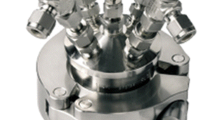Abstract
A very large amount of phenol-polluted waters are formed from the production of olive oil (olive mill waste water, OMWW), and the main problem associated with their disposal is a viable means of effective treatment. Biochemical processes used for treating OMWW are generally considered to be of high capital and operating costs with limited efficiency. This is mainly due to particularly high levels of phenolic compounds, which are considered major contributors to the toxicity and antibacterial activity of OMWW, and limit their microbial treatment and/or use as fertilizers. Although the use of bacterial and fungal enzymes has gained interest in studies pertaining to bioremediation applications, plant enzymes have been given less attention or even disregarded. In this view, this study aimed at investigating the use of a crude peroxidase preparation from onion solid by-products for oxidising hydrocaffeic acid, a typical o-diphenol with a structure very similar to various phenolic derivatives that may occur in OMWW. Increased enzyme activity was observed at a pH value of 4, but considerable activity was also retained for pH upto 7. Favourable temperatures for increased activity varied between 30 and 50 °C, 40 °C being the optimal. Liquid chromatography–mass spectrometry analysis of a homogenate/H2O2-treated hydrocaffeic acid solution revealed the existence of three major oxidation products, which were identified as dehydrodimers. Based on the data generated, a putative pathway for the formation of the peroxidase-mediated hydrocaffeic dehydrodimers was proposed.









Similar content being viewed by others
Abbreviations
- 4-AAP:
-
4-Aminoantipyrine
- BGP:
-
Bitter gourd peroxidase
- CA:
-
Caffeic acid
- HCA-OP:
-
Hydrocaffeic acid oxidation product
- CouA:
-
p-Coumaric acid
- FA:
-
Ferulic acid
- HCA:
-
Hydrocaffeic acid
- HRP:
-
Horseradish peroxidase
- LC-MS:
-
Liquid chromatography-mass spectrometry
- OMWW:
-
Olive mill waste water
- OSWH:
-
Onion solid waste homogenate
- SA:
-
Sinapic acid
- SBP:
-
Soybean peroxidase
- SD:
-
Standard deviation
- TMP:
-
Tomato peroxidase
- TNP:
-
Turnip peroxidase
References
Azbar N, Bayram A, Filibeli A, Muezzinoglu A, Sengul F, Ozer A (2004) Crit Rev Environ Sci Technol 34:209–247
Karam J, Nicell JA (1997) J Chem Tech Biotechnol 69:141–153
Tatsumi T, Wada S, Ichikawa H (1996) Biotechnol Bioeng 51:126–130
Wu Y, Taylor KE, Biswas N, Bewtra JK (1997) Water Res 31:2699–2704
Tong Z, Qingxiang Z, Hui H, Qin L, Yi Z (1998) Chemosphere 37:1571–1577
Wagner M, Nicell JA (2002) Water Res 36:4041–4052
Cheng J, Yu SM, Zuo P (2006) Water Res 40:283–290
Dalal S, Gupta MN (2007) Chemosphere 67:741–747
Singh A, Billingsley KA, Ward OP (2000) Bioproc Eng 23:421–425
Huang Q, Weber WJ (2005) Environ Sci Technol 39:6029–6036
Caza N, Bewtra JK, Biswas N, Taylor KE (1999) Water Res 33:3012–3018
Flock C, Bassi A, Gijzen M (1999) J Chem Technol Biotechnol 74:303–309
Wilberg K, Assenhaimer C, Rubio J (2002) J Chem Technol Biotechnol 77:851–857
Kennedy K, Alemany K, Warith M (2002) Water SA 28:149–158
Akhtar S, Khan AA, Husain Q (2005) Chemosphere 60:291–301
DellaGreca M, Previtera L, Temussi F, Zarrelli A (2004) Phytochem Anal 15:184–188
Obied HK, Allen MS, Bedgood DR Jr, Prenzler PD, Robards K (2005) J Agric Food Chem 53:9911–9920
De Marco E, Savarese M, Paduano A, Sacchi R (2007) Food Chem 104:858–867
Bradford MM (1976) Anal Biochem 72:248–254
Takahama U, Hirota S (2000) Plant Cell Physiol 41:1021–1029
González PS, Capozucca CE, Tigier HA, Milrad SR, Agostini E (2006) Enzyme Microb Technol 39:647–653
Wright H, Nicell JA (1999) Biores Tech 70:69–79
Duarte-Vázquez MA, Ortega-Tovar MA, García-Almendarez BE, Regalado C (2002) J Chem Technol Biotech 78:42–47
Huang Q, Weber WJ (2004) Environ Sci Technol 38:5238–5245
Tong Z, Qingxiang Z, Hui H, Qin L, Yi Z (1997) Chemosphere 34:893–903
Geng Z, Rao J, Bassi AS, Gijzen M, Krishnamoorthy N (2001) Catal Today 64:233–238
Akhtar S, Husain Q (2006) Chemosphere 65:1228–1235
Bassi A, Geng Z, Gijzen M (2004) Eng Life Sci 4:125–130
Bódalo A, Gómez JL, Gómez E, Bastida J, Máximo MF (2006) Chemosphere 63:626–632
Yamada K, Shibuya T, Noda M, Uchiyama N, Kashiwada A, Matsuda K, Hirata M (2007) Biosci Biotechnol Biochem 71:2503–2510
Veitch NC (2004) Phytochem Rev 3:3–18
Ralph J, Bunzel M, Marita JM, Hatfield RD, Lu F, Kim H, Schatz PF, Grabber JH, Steinhart H (2004) Phytochem Rev 3:79–96
Arrieta-Baez D, Stark RE (2006) Phytochem 67:743–753
Yu B-B, Han X-Z, Lou H-X (2007) J Agric Food Chem 55:7753–7757
Liu H-L, Wan X, Huang X-F, Kong L-Y (2007) J Agric Food Chem 55:1003–1008
Oudgenoeg G, Hilhorst R, Piersma SR, Boeriu CG, Gruppen H, Hessing M, Voragen AGJ, Laane C (2001) J Agric Food Chem 49:2503–2510
Derat E, Shaik S (2006) J Amer Chem Soc 128:13940–13949
Hapiot P, Neudeck A, Pinson J, Fulcrand H, Neta P, Rolando C (1996) J Electroanal Chem 405:169–176
Petrucci R, Astolfi P, Greci L, Firuzi O, Saso L, Marrosu G (2007) Electrochim Acta 52:2461–2470
Pati S, Losito I, Palmisano F, Zambonin PG (2006) J Chrom A 1102:184–192
Author information
Authors and Affiliations
Corresponding author
Rights and permissions
About this article
Cite this article
Agha, A.E., Makris, D.P. & Kefalas, P. Hydrocaffeic acid oxidation by a peroxidase homogenate from onion solid wastes. Eur Food Res Technol 227, 1379–1386 (2008). https://doi.org/10.1007/s00217-008-0854-6
Received:
Revised:
Accepted:
Published:
Issue Date:
DOI: https://doi.org/10.1007/s00217-008-0854-6




